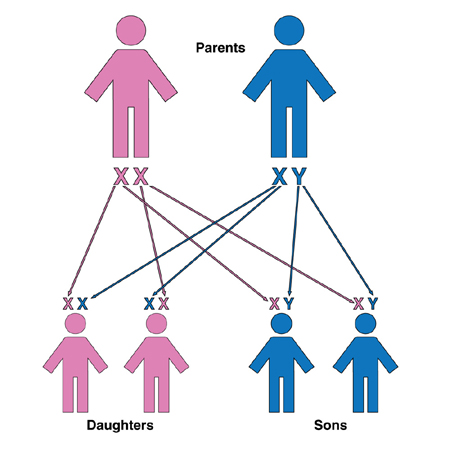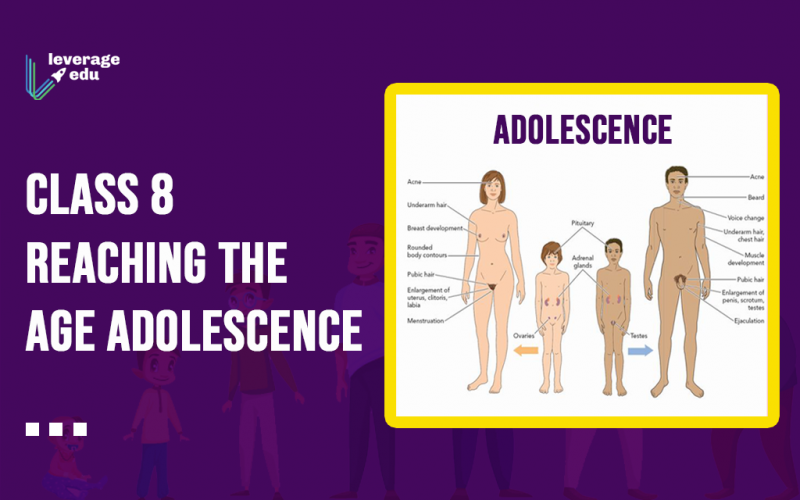Reaching the age of adolescence is the 10th chapter of the class 8 science NCERT book. It explains the process of adolescence, what it means and what changes occur in this age. In this blog, we will read some of the important notes on Class 8 Reaching the Age of Adolescence.
This Blog Includes:
The PDF for this chapter is available here.
Brief Notes on Class 8 Reaching the Age of Adolescence
Adolescence
The period of life when the body undergoes changes leading to reproductive maturity is called adolescence. It begins around the age of 11 and lasts up to 18 or 19 years of age. Since this period covers the teens (13 to 19 years of age) adolescents are also called teenagers. In girls, adolescence may begin a year or two earlier than boys but the period of adolescence varies from person to person.
Puberty
These changes in the human body during adolescence mark the onset of puberty. The most important change which marks puberty is that boys and girls become capable of reproduction and it ends when an adolescent reaches reproductive maturity.
Changes at Puberty
Increase in Height
The sudden increase in height is one of the most noticeable changes during puberty. At this time the long bones of the arms and the legs elongate and make a person tall. Initially girls grow faster than boys but by about 18 years of age both reach their maximum height. The rate of growth in height varies in different individuals. Height depends on the genes inherited from parents. Having a well-balanced diet helps the bones, muscles and other parts of the body get adequate nourishment for growth.
Change in Body Shape
In boys, the shoulders generally broaden as a result of growth whereas in girls the region below the waist becomes wider. In boys, the muscles of the body grow more prominently than in girls.
Voice Change
At puberty, the voice box or the larynx begins to grow and because the boys develop larger voice boxes it can be seen as a protruding part of the throat called Adam’s apple. In girls, the larynx is hardly visible from the outside because of its small size. Girls generally have a high pitched voice whereas boys develop a deep voice.
Increased Activity of Sweat and Sebaceous Glands
During puberty, the secretion of sweat glands and sebaceous glands (oil glands) increases due to which many young people get acne and pimples on the face.
Development of Sex Organs
At puberty, male sex organs like the testes and penis develop completely. In girls, the ovaries enlarge, eggs begin to mature and the ovaries start releasing mature eggs.
Reaching Mental, Intellectual and Emotional Maturity
Adolescents become more independent than before and are also self-conscious. Intellectual development takes place and they tend to spend considerable time thinking and dreaming. It is the time in one’s life when the brain has the greatest capacity for learning. Sometimes an adolescent may feel insecure while trying to adjust to the changes in the body and mind. But these changes are a natural part of growing up.
Secondary Sexual Characters
In girls, breasts begin to develop at puberty and boys grow facial hair and hair on the chest. As these features help distinguish the male from a female they are called secondary sexual characters. In both boys and girls, hair grows under the arms and in the pubic region.
Role of Hormones in Initiating Reproductive Function
Endocrine glands release hormones into the bloodstream to reach a particular body part called target site. The target site responds to the hormone secreted by various endocrine or ductless glands in the body. The testes and ovaries secrete hormones which are responsible for the male and female secondary sexual characters. Further these hormones are under the control of hormones from the pituitary gland which makes ova mature in the ovaries and sperms form in the testes.
Reproductive Phase of Life in Humans
In females, the reproductive phase of life begins at puberty when ova begin to mature and generally lasts till the age of approximately 45 to 50 years until menopause.
- Ovum matures and is released by one of the ovaries once in about 28 to 30 days. During this period the walls of the uterus become thick so as to receive the egg in case it is fertilized and begins to develop which results in pregnancy.
- If fertilization does not occur the released egg and the thickened lining of the uterus along with its blood vessels are shed off and this is called menstruation. Menstruation occurs once in about 28 to 30 days.
- The first menstrual flow begins at puberty and is termed menarche.
- At 45 to 50 years of age, the menstrual cycle stops which is termed menopause.
Determination of Sex of a Baby
Inside the zygote is the instruction for determining the sex of the baby, present in the thread-like structures called chromosomes. All human beings have 23 pairs of chromosomes in the nuclei of their cells. Two chromosomes out of these are the sex chromosomes named X and Y. A female has two X chromosomes while a male has one X and one Y chromosome.

The unfertilized egg always has one X chromosome and sperms are of two kinds, one with an X chromosome and the other has a Y chromosome. When a sperm containing X chromosome fertilizes the egg the zygote will have two X chromosomes and develop into a female child. If the sperm contributes a Y chromosome to the egg the zygote will develop into a male child.
Other Hormones
The hormones secreted by the pituitary gland stimulate testes and ovaries to produce their hormones. The pituitary gland is an endocrine gland and is attached to the brain. Apart from them there are other endocrine glands in the body such as thyroid, pancreas and adrenals.
- Goitre is a disease of the thyroid gland when it does not produce the hormone thyroxine properly.
- Diabetes is caused by the pancreas not producing the hormone insulin in sufficient quantities.
- The adrenal glands secrete hormones that maintain the correct salt balance in the blood and also produce the hormone adrenaline. It helps the body to adjust to stress when one is very angry or worried. The thyroid and adrenals secrete their hormones when they receive orders from the pituitary gland through its hormones. The pituitary also secretes growth hormone which is necessary for the normal growth of a human being.
- Metamorphosis– The change from larva to adult in insects is called metamorphosis. It is controlled by insect hormones. In a frog, it is controlled by thyroxine, the hormone produced by the thyroid. Thyroxine production requires the presence of iodine in water in the lack of which the tadpoles cannot become adults.
Nutritional Needs of the Adolescents
Adolescence is a stage of rapid growth and development hence a balanced diet is needed which means that the meals include proteins, carbohydrates, fats and vitamins in requisite proportions.
- Our Indian meal of roti/rice, dal (pulses) and vegetables is a well-balanced meal. Milk is a balanced food in itself and fruits also provide required nourishment. Iron builds blood and iron-rich food such as leafy vegetables, jaggery, meat, citrus, amla are good for adolescents
- Physical exercise like walking and playing outdoors in fresh air keeps the body fit and healthy.
- So is the need of a cleanliness routine important without which one would be gross and get infected by diseases.
- Drugs should be avoided because they are addictive and harm the body in the long run by ruining health and happiness. AIDS can pass on to a normal person from an infected person by sharing the syringes used for injecting the drugs. It can be transmitted to an infant from the infected mother through her milk. This disease can also be transmitted through sexual contact with a person infected with HIV.
FAQs
The period of life when the body undergoes changes leading to reproductive maturity is called adolescence. It begins around the age of 11 and lasts up to 18 or 19 years of age. Since this period covers the teens (13 to 19 years of age) adolescents are also called teenagers. In girls, adolescence may begin a year or two earlier than boys but the period of adolescence varies from person to person.
The characteristics of adolescence are increase in height, change in the shape of the body and voice, increased secretion of oil and sweat glands, development of sex organs and secondary sexual features. The detailed explanation of each characteristic is given above.
The process of shedding off unfertilized eggs and the thickened lining of the uterus along with its blood vessels is called menstruation. Menstruation occurs once in about 28 to 30 days from the onset of puberty in girls and lasts till menopause at the age of 45-50.
Also Read:
Class 8 Science
Science Projects for Class 8
Class 8 English
NCERT Class 8 Maths Syllabus
List of NCERT Books Class 8
We hope these notes on Class 8 Reaching the Age of Adolescence helped you in understanding the chapter much better. If you need more help with this or any other chapter we have notes for all the other class 8 science chapters too. Check Leverage Edu blogs for other subjects for class 8 and get better marks in your exams. All the best to you!
-
It was a very good note thank you very much, sir, you showed us all this.
-
Thanks for your comment.
You can further check: The Making of National Movement Class 8
Ruling the Countryside Class 8 Notes
-
-
I want notes of reaching the age of adolescence
-
Hello Adarsh,
You can view or download the notes from the PDF attached to the blog itself.
-

 One app for all your study abroad needs
One app for all your study abroad needs






















 45,000+ students trusted us with their dreams. Take the first step today!
45,000+ students trusted us with their dreams. Take the first step today!



5 comments
It was a very good note thank you very much, sir, you showed us all this.
Thanks for your comment.
You can further check: The Making of National Movement Class 8
Ruling the Countryside Class 8 Notes
I want notes of reaching the age of adolescence
Hello Adarsh,
You can view or download the notes from the PDF attached to the blog itself.
Thanks for this informative blog
and are there any blogs for When People Rebel: Revolt of 1857